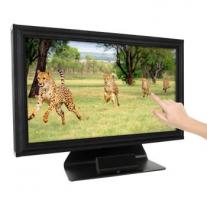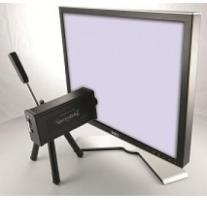Visual Stimulation / ViSaGe MKII Stimulus Generator
ViSaGe MKII Stimulus Generator

ViSaGe makes it simple to present calibrated visual stimuli on CRT, LCD, DLP and OLED based displays with precision timing, and provides a robust and reliable mechanism to synchronise the stimulus presentation with external data collection equipment, including button boxes or eye trackers, motion trackers, electrophysiological amplifiers, and MRI scanners. It is the ideal choice for cognitive, psychophysical, and neurophysiological investigations of vision and the brain.







Technical Specification |
|
Connectivity |
|
Connectors |
|
Supplied Software |
|
Packaging |
|
Minimum System Requirements |
|
| Hardware feature | VSG hardware version | ||||
|---|---|---|---|---|---|
| ViSaGe PCIe | ViSaGe AGP | VSG2/5 | VSG2/4 | VSG2/3 | |
| PC bus type | 4 lane, PCI Express | 66 MHz, 64 bit, 4x AGP | 33 MHz, 32 bit PCI | 8 MHz, 16 bit ISA | 8 MHz, 16 bit ISA |
| Max. transfer rate from PC DRAM | >40 MB/s, plus hardware acceleration | >40 MB/s, no hardware acceleration | 4 MB/s | 1.5 MB/s | 1.5 MB/s |
| Output resolution | 14 bit | 14 bit | 15 bit | 15 bit, 8 bit | 12 bit, 8 bit |
| DAC system | 3 x various manufacturers | 3 x various manufacturers | 2 x ADV7162 | 2 x Bt460 | 2 x Bt460 |
| Graphics processor | 3DLabs Wildcat P25 | 3DLabs Wildcat P9 | TMS34020 | TMS34020 | TMS34020 |
| Graphics processor speed | N/A | N/A | 50 MHz | 40 MHz | 40 MHz |
| Framestore - standard configuration (AKA "VideoPage" memory area) | 256 MB | 256 MB - [1] | 8 MB | 4 MB | 4 MB |
| Framestore - add-on sizes | N/A | N/A | 24 MB | 32 MB, 16 MB | 32 MB, 16 MB |
| Max. framestore size | 256 MB | 256 MB - [1] | 32 MB | 68 MB (2 x 32 MB) | 68 MB (2 x 32 MB) |
| Framestore pixel size | 4 bytes | 4 bytes | 1 byte or 4 bytes | 1 byte | 1 byte |
| VideoPage video modes | 8 bit palette 24 bit true colour |
8 bit palette 24 bit true colour |
8 bit palette 24 bit true colour |
8 bit palette | 8 bit palette |
| Overlay plane size (AKA "OverlayPage" memory area) | 16 MB | 16 MB | 2 MB | 2 MB | 2 MB |
| OverlayPage pixel size | 4 bytes | 4 bytes | 1 byte | 1 byte | 1 byte |
| OverlayPage video modes | 8 bit palette 24 bit true colour |
8 bit palette 24 bit true colour |
2 bit palette | 4 bit or 8 bit palette, | 4 bit or 8 bit palette |
| On-board, non-display memory (AKA "ScratchPage" memory area) | 8 MB - [2] | 8 MB - [2] | 8 MB | 4 MB | 4 MB |
| ScratchPage pixel size | 4 bytes or 1 byte | 4 bytes or 1 byte | 1 byte or 4 bytes | 1 byte | 1 byte |
| ScratchPage video modes | 8 bit palette 24 bit true colour |
8 bit palette 24 bit true colour |
8 bit palette | 8 bit palette, | 8 bit palette |
| Local, non-display memory (AKA "HostPage" memory area) | Unlimited - [3] | Unlimited - [3] | Unlimited - [3] | Unlimited - [3] | Unlimited - [3] |
| HostPage pixel size | 4 bytes or 1 byte | 4 bytes or 1 byte | 1 byte or 4 bytes | 1 byte | 1 byte |
| HostPage video modes | 8 bit palette 24 bit true colour |
8 bit palette 24 bit true colour |
8 bit palette 24 bit true colour |
8 bit palette, | 8 bit palette |
| Digital I/O | Ten in Ten out |
Ten in Ten out |
Ten in Ten out |
Eight in Nine out |
Five in Nine out |
| Analog I/O | Six 16 bit in Two 16 bit out |
Six 16 bit in Two 16 bit out |
Five 12 bit in One 12 bit out |
Seven 12 bit in One 12 bit out |
Seven 12 bit in One 12 bit out |
| Hardware reaction timing (requires CB6, CT6, CB3 or CT3 response box) |
Yes (only CB6, CT6) | Yes (only CB6, CT6) | Yes | Yes | Yes |
| Max. pixel clock | 160 MHz | 160 MHz | 150 MHz | 120 MHz | 120 MHz |
| Max. line rate | 200 kHz | 200 kHz | 200 kHz | 200 kHz | 200 kHz |
| Max. frame rate | 200 Hz | 200 Hz | 500 Hz | 500 Hz | 500 Hz |
| Support for VSGDSP | No | No | No | Yes | Yes |
| Support for RG1, RG2 | No | No | No | Yes | Yes |
| Supported in VSG software version | 8.1 or later | 8 | 8, 6 | 8, 6, 5, 4 | 8, 6, 5, 4 |
Important Notes
[1] - The original ViSaGe framestore was provided on a dual-head AGP graphics card. The framestore memory space was shared between the Windows desktop and the VSG Stimulus Display. This means that some of the 256MB area was reserved for use by the Windows display.
[2] - The ViSaGe on-board, non-display memory space is emulated using main PC memory and is provided only for backwards compatibility. There is no additional benefit in using this memory space compared to the off-board, non-display, virtual memory space.
[3] - The off-board, non-display memory space is a virtual VSG memory area which uses main PC memory. The memory space size is dependent on the amount of free RAM in your PC.


